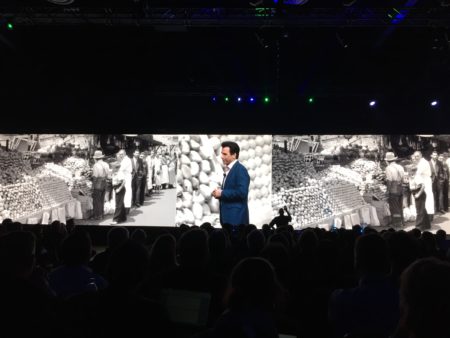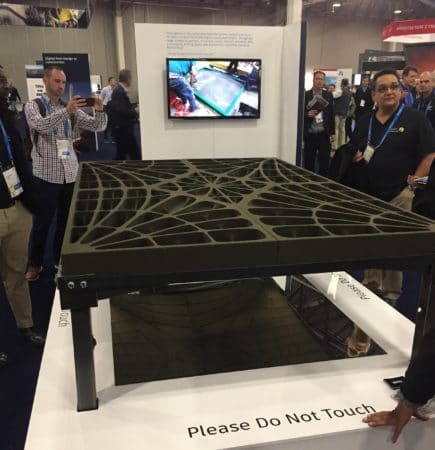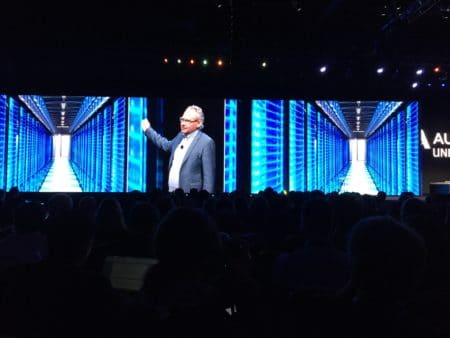AT AUTODESK UNIVERSITY, CEO ANDREW ANAGNOST’S provocative keynote provided some powerful frameworks for understanding how jobs and industrial fields change—not disappear entirely—under new forms of automation.
Using two examples from recent history—banking and food farming—AU attendees gained a framework for understanding that automation doesn’t just take work away, it enables us to focus on the work that adds value.
What Banking and Farming Teach Us
Anagnost noted that in the case of the banking industry after the rise of the ATM (automated teller machine), the work of the teller simply shifted towards problem-solving, new products, and forging customer relationships. What “the tellers discovered is that having a sunset on what they did automated, didn’t make the other things they did redundant, it made them much more important. It made their work more creative, more stimulative…it made their jobs better.”
…the tellers discovered is that having a sunset on what they did automated, didn’t make the other things they did redundant, it made them much more important. It made their work more creative, more stimulative…it made their jobs better.
In case some attendees weren’t entirely convinced by the historical parallel, Anagnost went on to talk about farming and food production. He noted that in the year 1900, 40 percent of all working Americans worked in farming. Today only 2 percent do. “100 years ago the value chain for food started at the farm and it ended at the market,” he noted. “But today that value chain extends way beyond just growing and selling; it extends into cooking shows, and plant-based needs, and gluten-free everything.” (image 01)
“Automation has allowed us to farm [the] land more effectively and with better precision.”

01 – Autodesk CEO Andrew Anagnost, during his keynote, talks about how automation in food farming didn’t destroy all food industry jobs but actually led to all the new types of food industry jobs we have today.
Both of these examples have valuable lessons. In the case of the latter, what we see is that our technologies have allowed a small number to feed the many, while those still connected to food industries have spread out into all kinds of new and more creative jobs—all linked to food. The power in automation of farming is still critical as our world population balloons over the next decade and in the face of environmental crisis. In the case of the former, banking demonstrates a parallel where a literal robot of sorts was injected into the industry. Humans at both the customer and worker level benefitted. As we engage with new forms of robots in both AEC and manufacturing, parallel lessons from the banking world abound.
Our Jobs Will Get Better
Anagnost mentions the parallel of the transportation business. 4 million people’s jobs involve driving today, but autonomous trucking, drone-based delivery, and mass-transit revolutions like HyperLoop can dramatically eliminate millions of those jobs. Still, he contends, folks will find work in other mobility sector fields. He believes the ecosystem behind mobility will only get better, and so will the jobs.

02 – Robotics, machine learning and algorithmic-aided design (AAD) are some of the newest forms of technologies poised to transform the world of construction. From the AU 2018 show floor, 3D sand-printed floor system—cutting-edge research by Dr. Matthias Rippmann, Ursala Frick, and Dr. Andrew Liew.
“Automating our repetitive tasks doesn’t make the other tasks we do redundant,” he said again, “it makes them more important. It increases the importance of our expertise and our creativity.” “Removing repetitive tasks means we have less friction in our daily workflows and this enables us to focus more on the tasks that add value.” In short, what he suggested to the AU audience is that we shouldn’t just concern ourselves with our jobs disappearing but how our jobs are changing and what skills we will need to thrive in the near future. (image 02)
In today’s AEC industry, for example, western societies are facing a critical worker shortage, brought about by aging Baby Boomers and a very strong global economy. As more people move to cities construction of buildings is at an all-time high—particularly in emerging markets like Asia.

03 – Atkins of the UK is a large multidisciplinary engineering firm with a new Forge-based tool called Caterpillar.
At AU 2018 it was clear from exhibitors on the show floor how much Autodesk is paying attention to the construction industry. “Contech,” as it is sometimes labeled for short, is a massive new investment surge in AEC and Autodesk is nearly staking its future on it. (image 02) Shortly after AU 2018 ended the company announced its acquisition of California-based PlanGrid, one of the hottest growing companies in the construction technology software sector. The $875 million acquisition will immediately bolster Autodesk’s stake in the construction sector, where the company faces serious competition around other formidable large players, including the likes of Oracle.
MORE: Autodesk To Acquire SaaS Construction Industry Darling ‘PlanGrid’—What It Can Mean
During the keynote, attendees got to witness first hand how Autodesk’s Forge platform is not just powering its own tools like BIM 360—which will now integrate with PlanGrid if the acquisition goes through—but how large customers are building their own bespoke cloud tools around it. UK-based Atkins, a large multi-disciplinary design and engineering company, came on stage to showcase the beta version of Caterpillar. Built on the Forge Platform it aims to give the company and its users and clients a “high-frequency data management” (HFDM) platform which is accessible on any device. It will help evaluate cost impacts on design and engineering decisions in real-time, among many other features. (image 03)
Advertisement
Autodesk is all about “open” now. Gone seem to be the days when it relied on file-format lock-in around AutoCAD as its primary competitive advantage. And the reason this is so is that of the importance of data. Autodesk CTO Scott Borduin told the AU crowd that “we need to develop solutions that allow data to flow through our tools, our competitor’s tools—any of the tools that are in your ecosystem….” (image 04)
That last phrase, “your ecosystem” has extra importance and multiple meanings. It means firstly that Autodesk recognizes that ‘best-of-breed’ tools exist by the dozens globally outside of its well-stocked family of leading software offerings. (See: Architosh, “Autodesk Explains Project Quantum—And Why It Matters in AEC,” 3 May 2017).

04 – Scott Borduin, chief technology officer, talks up the importance of data in the automation transformation that is sweeping the industries Autodesk serves.
It also means, perhaps most importantly, that cloud and mobile have transformed the software industry and that cloud tools today must provide APIs that enable data to flow from one cloud tool to another. And that data flow is key. As Borduin said during his segment of the talk, “data is a positive sum game.” And with rhetorical devices worthy of any Jedi Master he further opined: “More data equals more knowledge; more knowledge equals more insights; more insights equals better outcomes.”
Closing Thoughts
This year’s theme was “The Opportunity for Better.” For Autodesk’s leadership in Andrew Anagnost, it means forging pathways for data to flow between apps—even through competitor apps. It means getting more software companies to build on its Forge Platform— its own next-gen cloud development platform. It means more integrations with BIM 360 and the soon-to-be-acquired PlanGrid. And it really means getting their customers to recognize the power of data and its intrinsic value.
(disclosure: Autodesk, Inc., paid for lodging and some meals at AU 2018.)




Reader Comments
Comments for this story are closed